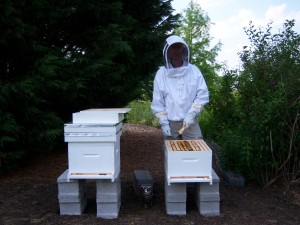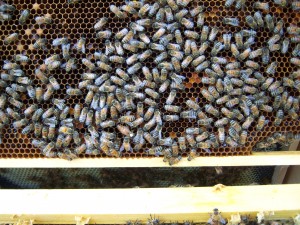Posts tagged honeybees

Honeybees after their first week
0The Honeybees had a pretty ideal first week. The weather was pretty warm and we had lots of sun. This is when the bees are the busiest and happiest. One thing I learned in my classes was not to bother the bees and a cold or rainy day. The bees are bored and they are just look for trouble.
One hive, right from the first day, has been more active than the other. I can typically count 10 bees coming and going for every one at the other hive. This can’t be good. I could see bees landing at the entrance of hive 2 loaded with pollen (stuck all over their back legs), some bright yellow, some darker orange. The new bee larvae needs to be fed pollen or stuff made with pollen, so seeing all this pollen moving into the hive is a good thing. The nucleus colony I started with has frames of brood (developing babies), honey, some pollen, and some uncommitted comb that can be used for brood, pollen or honey. I can only hope that hive 1 has enough pollen and the bees are busier on the inside of the hive attending to the ‘nursery’. Maybe hive 1 has more young bees that work inside the hive and hive 2 has more foragers who go out to collect food.
The bees will work it out. As long as the weather is hot and sunny, there should be food available and every three weeks or so, a whole new generation of bees is born and begin their life cycles.
I don’t expect to harvest any honey this year. I just want to make sure there is enough honey to get the bees through the winter. Occassionally it is necessary to combine two weak hives into one hive to survive the winter. It is better to start spring with one healthy hive than two dead ones. But combining means that I will need to get another queen and do a ‘split’ in the mid spring to get back to two hives.

